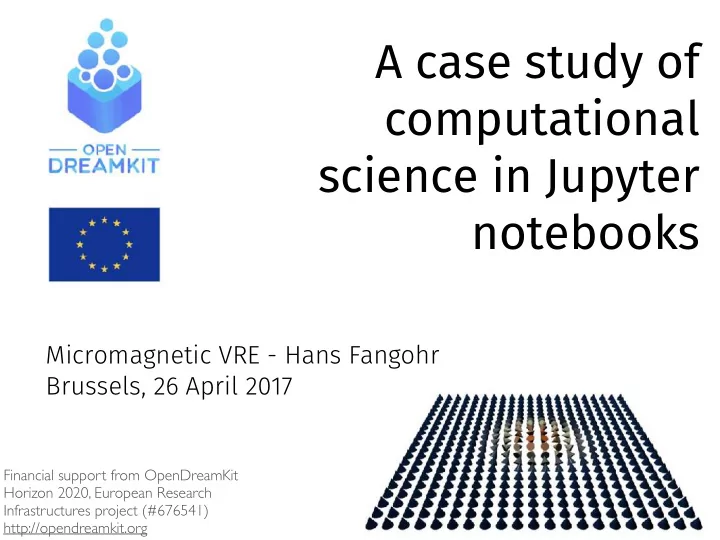

A case study of computational science in Jupyter notebooks Micromagnetic VRE - Hans Fangohr Brussels, 26 April 2017 Financial support from OpenDreamKit Horizon 2020, European Research Infrastructures project (#676541) http://opendreamkit.org
Overview • What is micromagnetics? • State-of-the-art micromagnetics simulation tool • Beyond state-of-the art: micromagnetic VRE • Summary 2
What is micromagnetics ? • magnetism at small length scales, typically nanometre to micrometre
Why magnetic nanostructures? 1. Interesting complex system with tuneable parameters and experiments 2. Applications include • magnetic data storage (hard disk) • cancer diagnostics and therapy • low energy magnetic logic (spintronics, skyrmionics) E. Dobisz et. al., Proceedings of IEEE 96, 1836 (2008) Curtis & Fangohr (2011)
Magnetic moment N m S 5
Magnetisation dynamics • Landau-Lifshitz-Gilbert (LLG) equation damping ∂ m ∂ t = γ ∗ m × H e ff + α m × ∂ m ∂ t precession H e ff H e ff H e ff = + = + H e ff H e ff H e ff 6
Different types of physics A: Align the magnetic moment to an external field 2 1 B: Align all magnetic moments to be parallel 2 1 7
More complicated case Two-dimensional sample. • Four interactions included (Exchange, Zeeman, • Anisotropy, Dzyaloshinskii-Moriya energy (DMI)) 8
Computational magnetism important • The number of problems that can be solved analytically is very limited. • Experimental techniques do not provide enough spatial and temporal resolution. Bit-patterned media (Seagate) Parkin, Science, 320, 190 (2008) 9
Micromagnetic model • Coarse graining to go from atoms to continuous magnetisation, known as micromagnetic model • Magnetisation in sample V is described by a continuous vector field m ( r ): m : V 7! R 3 V ⇢ R 3 • We have an equation of motion ∂ m ∂ t = f ( m ) • f is complicated, involves PDEs
State of the art micromagnetic simulation tool
Object Oriented MicroMagnetic Framework (OOMMF) • Probably the most widely used simulation tool • Developed at NIST, USA GUI • Cited over 2200 times in scientific publications • Written in C++, some Tcl glue / interface Tcl config file 12
Research workflow example For what cube edge length have vortex and flower states the same energy? vortex ? flower
Step 1: write simulation configuration
Step 1: write simulation configuration
Step 2: run simulation
Step 3: extract data from output file
Step 4: gather data, and repeat simulations… L flower vortex 8.0 ? 3.23 x 10 -16 8.1 ? ? 8.2 ? ? 8.3 ? ? 8.4 ? ? 8.5 ? ? 8.6 ? ? 8.7 ? ? 8.8 ? ? 8.9 ? ? 9.0 ? ? “Pushing one domino at a time”
Postprocessing • We plot the data we obtained by running separate plotting scripts or by using some Graphical User Interfaces (Python, MATLAB, Excel, Origin…) • Find crossing (here at ~8.45).
Issues with (OOMMF) workflow • Writing config files and extracting data is repetitive, manual process (or requires bash scripting) • Time consuming; error prone • Separate post processing and plotting scripts • Reproducibility?
Jupyter OOMMF
JOOMMF • Jupyter + OOMMF = JOOMMF • Micromagnetic Virtual Research Environment (VRE) • Enable running OOMMF simulations in Jupyter notebook (through Python interface to OOMMF)
Research example (repeated) with Jupyter OOMMF [Live demo in Notebook: standard_problem3.ipynb, online at https://github.com/OpenDreamKit/OpenDreamKit.github.io/ blob/master/meetings/2017-04-26-ProjectReviewPresentations/ joommf/standard_problem3.ipynb]
Benefits of JOOMMF • The entire workflow is contained in a single document, including computation, post processing and visualisation • Self documenting • Reproducible: re-execute cells in notebook • Easy to share & publish
Micromagnetic model integration in VRE [Live demo in Notebook: micromagneticmodel.ipynb online at https://github.com/OpenDreamKit/OpenDreamKit.github.io/ blob/master/meetings/2017-04-26-ProjectReviewPresentations/ joommf/micromagneticmodel.ipynb ]
Link to work packages • WP3 Component T3.8 - Python Python interface architecture • WP4 User T4.11- Jupyter Jupyter interface & interfaces visualisation T4.8 - 3d vis T4.13 - interactive doc Interactive tutorials & Cloud hosting T4.14 - cloud • WP2 T2.8 - workshops Dissemination Dissemination • WP7 Social T7.4 - evaluation Evaluation Aspects
Summary JOOMMF • Micromagnetic Virtual Research Environment (VRE) allows us to have documentation, models, code, code outputs, in a single file • Python interface to OOMMF supports component-based approach: can combine OOMMF with the tools from Python ecosystem • Improved effectiveness and reproducibility: not affordable for individual research groups but enabled by OpenDreamKit • All open source (joommf.github.io) • Micromagnetic VRE is specialised VRE built from the VRE Toolkit of OpenDreamKit, and • Demonstrates how computational mathematics underpins science and engineering
• To cite Jupyter-OOMMF, please use Marijan Beg, Ryan A. Pepper, Hans Fangohr: User interfaces for computational science: a domain specific language for OOMMF embedded in Python, American Institute of Physics, Advances 7, 056025 (2017) http://dx.doi.org/10.1063/1.4977225 also available online https://arxiv.org/abs/1609.07432 • Source code: http://joommf.github.io
Recommend
More recommend